Business Law Report: Business Structures, Company and Incorporation
VerifiedAdded on 2023/06/08
|9
|2569
|208
Report
AI Summary
This report delves into the realm of Australian business law, focusing on various business structures and the process of company incorporation. It begins by identifying and comparing three relevant business structures: sole trader, partnership, and company, highlighting their similarities and differences. The report then recommends the most suitable business structure for a hypothetical business venture involving Raj, Tom, and Sulin, considering their needs and concerns, and outlines the practical steps required to establish the recommended structure. Furthermore, the report examines case studies related to company law and incorporation, addressing issues of liability and corporate fraud. The report references the Australian Corporations Act 2001 and other relevant legal frameworks to provide a comprehensive analysis of business law principles in the Australian context.
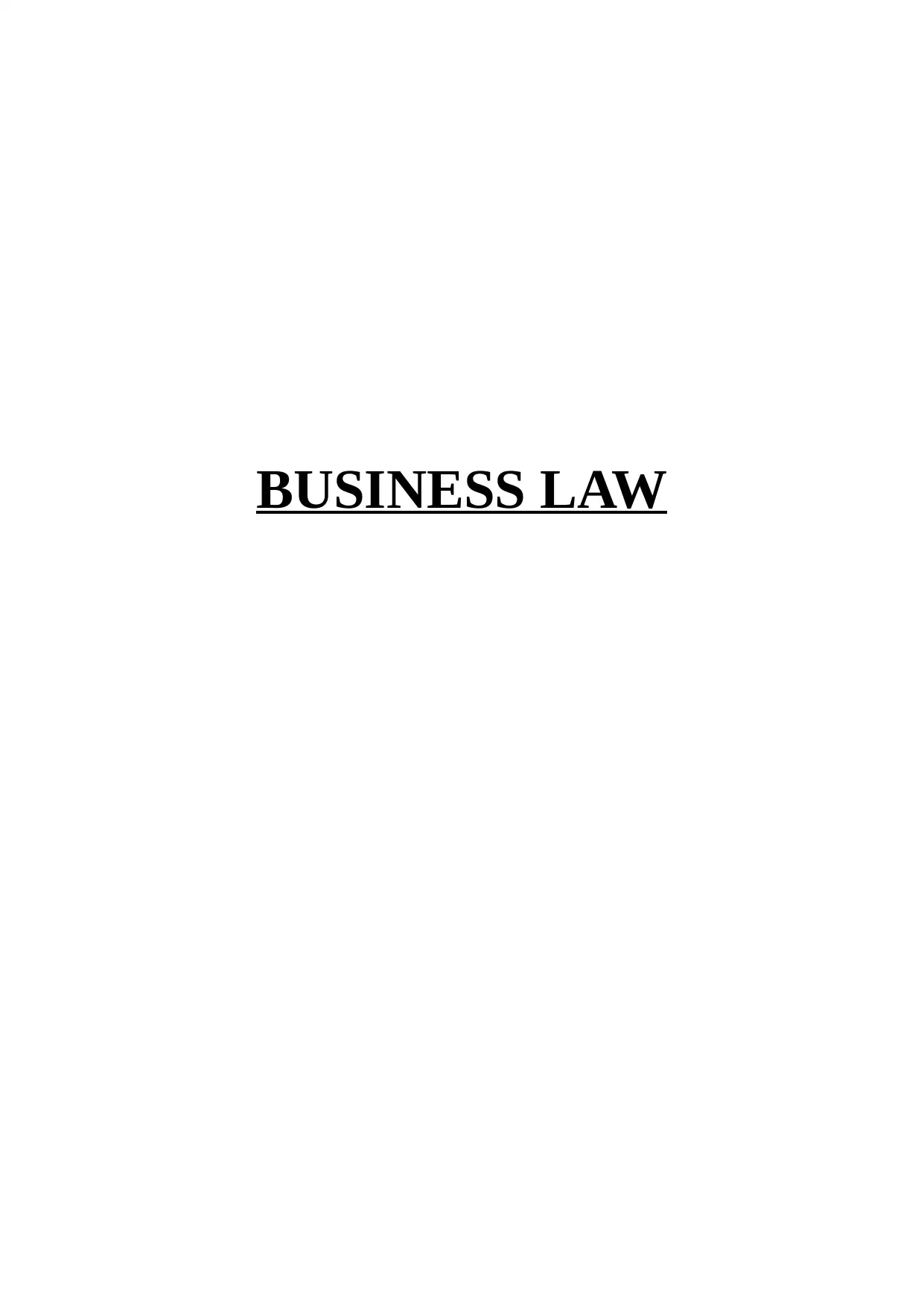
BUSINESS LAW
Paraphrase This Document
Need a fresh take? Get an instant paraphrase of this document with our AI Paraphraser
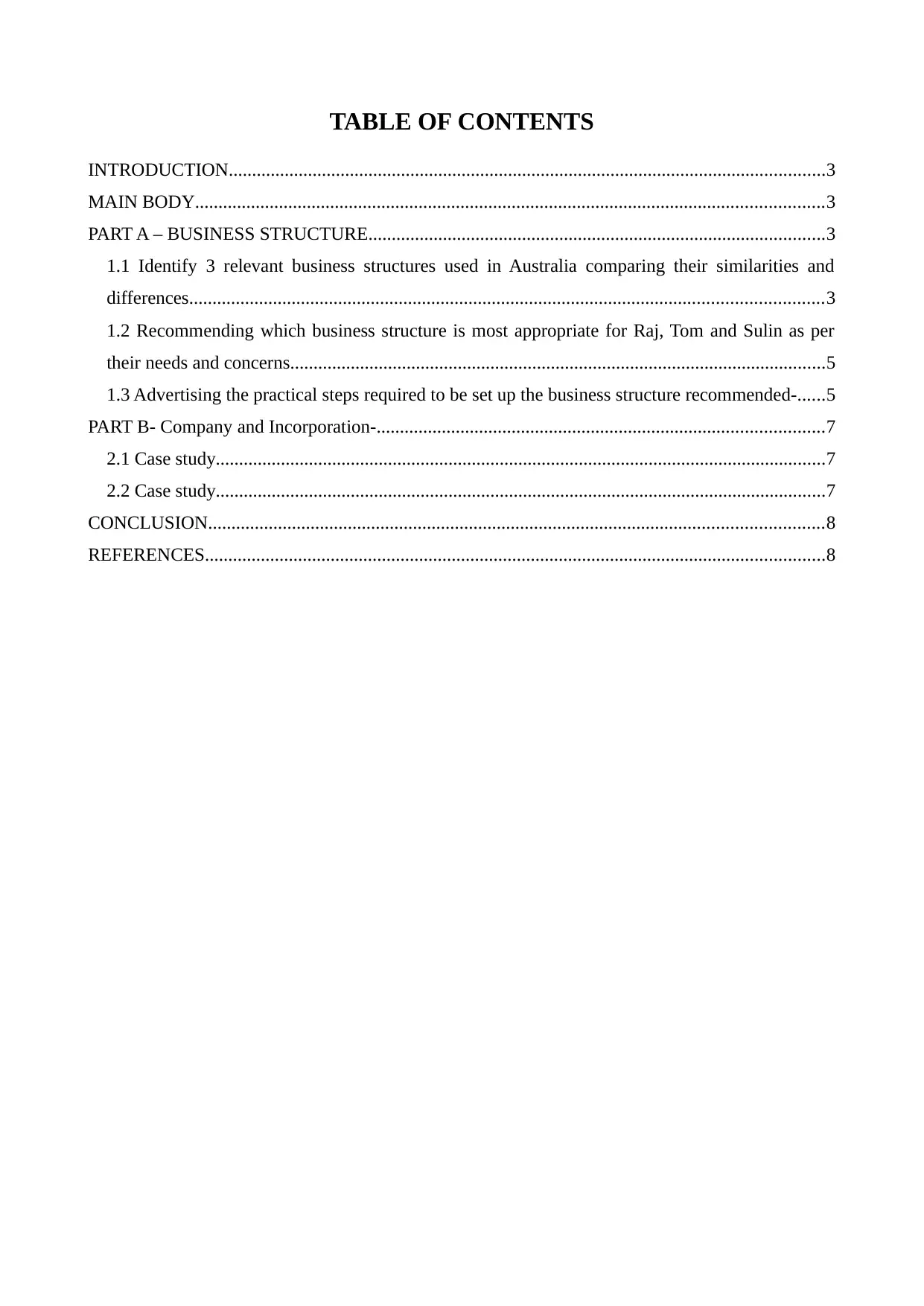
TABLE OF CONTENTS
INTRODUCTION................................................................................................................................3
MAIN BODY.......................................................................................................................................3
PART A – BUSINESS STRUCTURE..................................................................................................3
1.1 Identify 3 relevant business structures used in Australia comparing their similarities and
differences........................................................................................................................................3
1.2 Recommending which business structure is most appropriate for Raj, Tom and Sulin as per
their needs and concerns...................................................................................................................5
1.3 Advertising the practical steps required to be set up the business structure recommended-......5
PART B- Company and Incorporation-................................................................................................7
2.1 Case study...................................................................................................................................7
2.2 Case study...................................................................................................................................7
CONCLUSION....................................................................................................................................8
REFERENCES.....................................................................................................................................8
INTRODUCTION................................................................................................................................3
MAIN BODY.......................................................................................................................................3
PART A – BUSINESS STRUCTURE..................................................................................................3
1.1 Identify 3 relevant business structures used in Australia comparing their similarities and
differences........................................................................................................................................3
1.2 Recommending which business structure is most appropriate for Raj, Tom and Sulin as per
their needs and concerns...................................................................................................................5
1.3 Advertising the practical steps required to be set up the business structure recommended-......5
PART B- Company and Incorporation-................................................................................................7
2.1 Case study...................................................................................................................................7
2.2 Case study...................................................................................................................................7
CONCLUSION....................................................................................................................................8
REFERENCES.....................................................................................................................................8
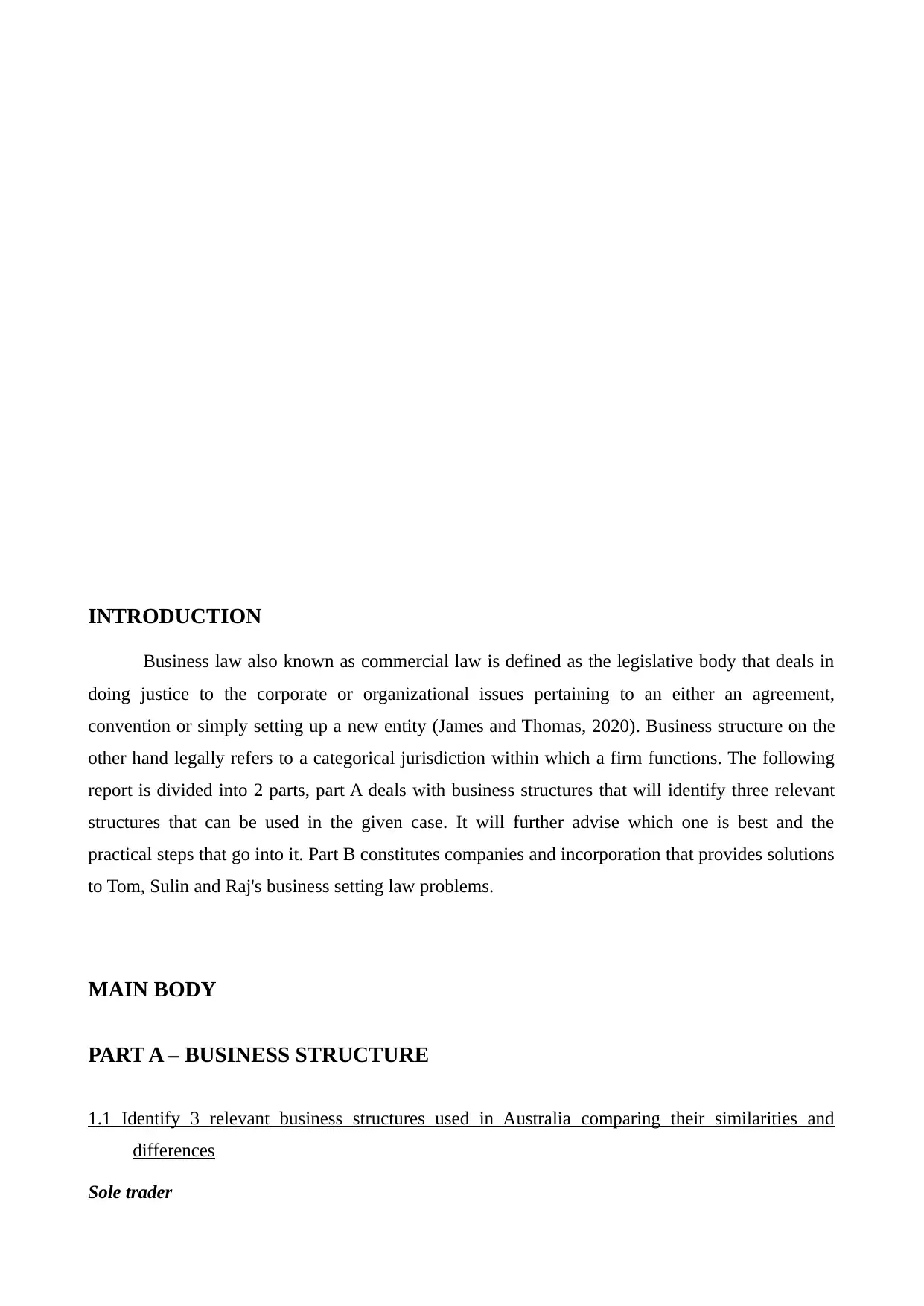
INTRODUCTION
Business law also known as commercial law is defined as the legislative body that deals in
doing justice to the corporate or organizational issues pertaining to an either an agreement,
convention or simply setting up a new entity (James and Thomas, 2020). Business structure on the
other hand legally refers to a categorical jurisdiction within which a firm functions. The following
report is divided into 2 parts, part A deals with business structures that will identify three relevant
structures that can be used in the given case. It will further advise which one is best and the
practical steps that go into it. Part B constitutes companies and incorporation that provides solutions
to Tom, Sulin and Raj's business setting law problems.
MAIN BODY
PART A – BUSINESS STRUCTURE
1.1 Identify 3 relevant business structures used in Australia comparing their similarities and
differences
Sole trader
Business law also known as commercial law is defined as the legislative body that deals in
doing justice to the corporate or organizational issues pertaining to an either an agreement,
convention or simply setting up a new entity (James and Thomas, 2020). Business structure on the
other hand legally refers to a categorical jurisdiction within which a firm functions. The following
report is divided into 2 parts, part A deals with business structures that will identify three relevant
structures that can be used in the given case. It will further advise which one is best and the
practical steps that go into it. Part B constitutes companies and incorporation that provides solutions
to Tom, Sulin and Raj's business setting law problems.
MAIN BODY
PART A – BUSINESS STRUCTURE
1.1 Identify 3 relevant business structures used in Australia comparing their similarities and
differences
Sole trader
⊘ This is a preview!⊘
Do you want full access?
Subscribe today to unlock all pages.

Trusted by 1+ million students worldwide
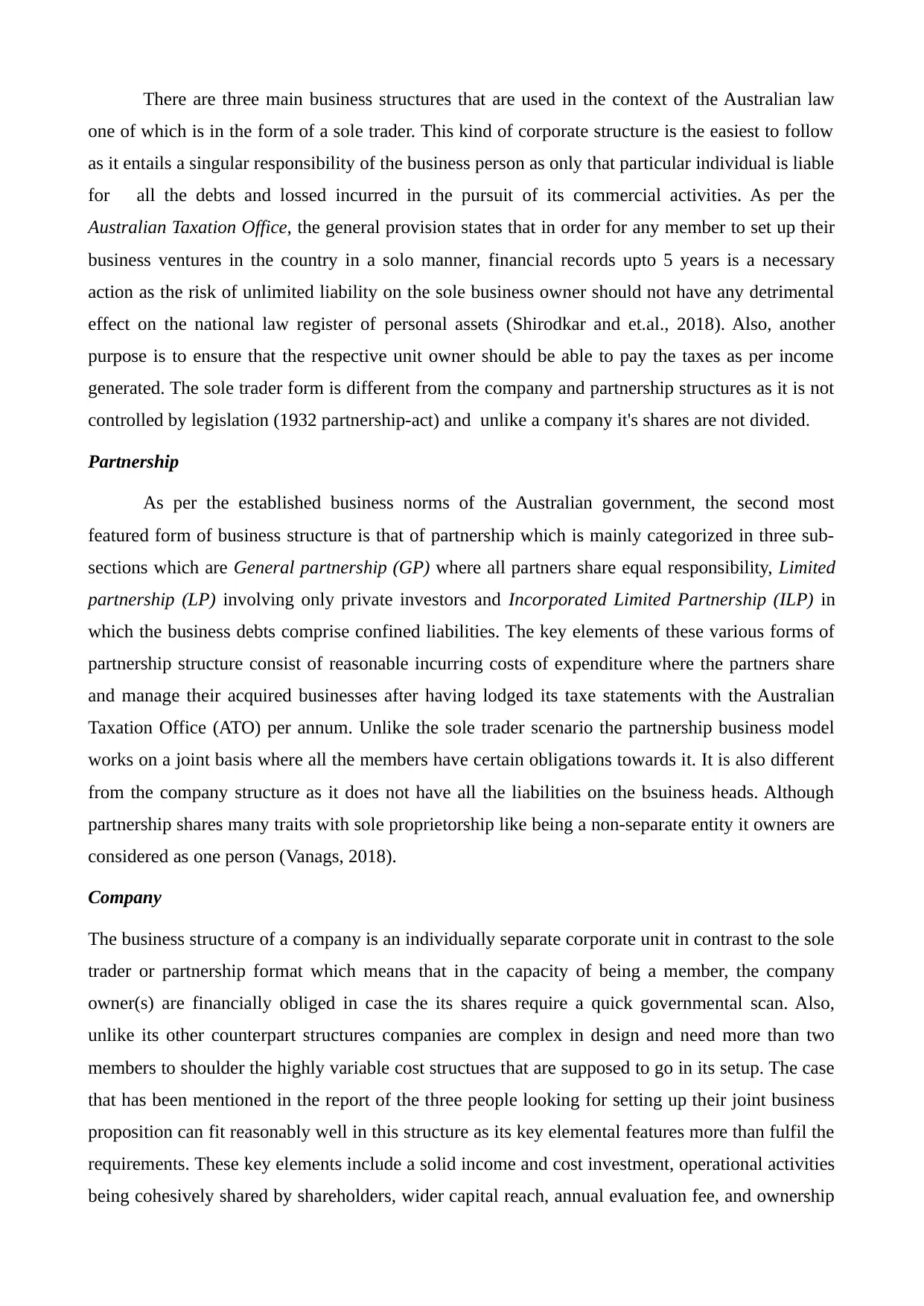
There are three main business structures that are used in the context of the Australian law
one of which is in the form of a sole trader. This kind of corporate structure is the easiest to follow
as it entails a singular responsibility of the business person as only that particular individual is liable
for all the debts and lossed incurred in the pursuit of its commercial activities. As per the
Australian Taxation Office, the general provision states that in order for any member to set up their
business ventures in the country in a solo manner, financial records upto 5 years is a necessary
action as the risk of unlimited liability on the sole business owner should not have any detrimental
effect on the national law register of personal assets (Shirodkar and et.al., 2018). Also, another
purpose is to ensure that the respective unit owner should be able to pay the taxes as per income
generated. The sole trader form is different from the company and partnership structures as it is not
controlled by legislation (1932 partnership-act) and unlike a company it's shares are not divided.
Partnership
As per the established business norms of the Australian government, the second most
featured form of business structure is that of partnership which is mainly categorized in three sub-
sections which are General partnership (GP) where all partners share equal responsibility, Limited
partnership (LP) involving only private investors and Incorporated Limited Partnership (ILP) in
which the business debts comprise confined liabilities. The key elements of these various forms of
partnership structure consist of reasonable incurring costs of expenditure where the partners share
and manage their acquired businesses after having lodged its taxe statements with the Australian
Taxation Office (ATO) per annum. Unlike the sole trader scenario the partnership business model
works on a joint basis where all the members have certain obligations towards it. It is also different
from the company structure as it does not have all the liabilities on the bsuiness heads. Although
partnership shares many traits with sole proprietorship like being a non-separate entity it owners are
considered as one person (Vanags, 2018).
Company
The business structure of a company is an individually separate corporate unit in contrast to the sole
trader or partnership format which means that in the capacity of being a member, the company
owner(s) are financially obliged in case the its shares require a quick governmental scan. Also,
unlike its other counterpart structures companies are complex in design and need more than two
members to shoulder the highly variable cost structues that are supposed to go in its setup. The case
that has been mentioned in the report of the three people looking for setting up their joint business
proposition can fit reasonably well in this structure as its key elemental features more than fulfil the
requirements. These key elements include a solid income and cost investment, operational activities
being cohesively shared by shareholders, wider capital reach, annual evaluation fee, and ownership
one of which is in the form of a sole trader. This kind of corporate structure is the easiest to follow
as it entails a singular responsibility of the business person as only that particular individual is liable
for all the debts and lossed incurred in the pursuit of its commercial activities. As per the
Australian Taxation Office, the general provision states that in order for any member to set up their
business ventures in the country in a solo manner, financial records upto 5 years is a necessary
action as the risk of unlimited liability on the sole business owner should not have any detrimental
effect on the national law register of personal assets (Shirodkar and et.al., 2018). Also, another
purpose is to ensure that the respective unit owner should be able to pay the taxes as per income
generated. The sole trader form is different from the company and partnership structures as it is not
controlled by legislation (1932 partnership-act) and unlike a company it's shares are not divided.
Partnership
As per the established business norms of the Australian government, the second most
featured form of business structure is that of partnership which is mainly categorized in three sub-
sections which are General partnership (GP) where all partners share equal responsibility, Limited
partnership (LP) involving only private investors and Incorporated Limited Partnership (ILP) in
which the business debts comprise confined liabilities. The key elements of these various forms of
partnership structure consist of reasonable incurring costs of expenditure where the partners share
and manage their acquired businesses after having lodged its taxe statements with the Australian
Taxation Office (ATO) per annum. Unlike the sole trader scenario the partnership business model
works on a joint basis where all the members have certain obligations towards it. It is also different
from the company structure as it does not have all the liabilities on the bsuiness heads. Although
partnership shares many traits with sole proprietorship like being a non-separate entity it owners are
considered as one person (Vanags, 2018).
Company
The business structure of a company is an individually separate corporate unit in contrast to the sole
trader or partnership format which means that in the capacity of being a member, the company
owner(s) are financially obliged in case the its shares require a quick governmental scan. Also,
unlike its other counterpart structures companies are complex in design and need more than two
members to shoulder the highly variable cost structues that are supposed to go in its setup. The case
that has been mentioned in the report of the three people looking for setting up their joint business
proposition can fit reasonably well in this structure as its key elemental features more than fulfil the
requirements. These key elements include a solid income and cost investment, operational activities
being cohesively shared by shareholders, wider capital reach, annual evaluation fee, and ownership
Paraphrase This Document
Need a fresh take? Get an instant paraphrase of this document with our AI Paraphraser
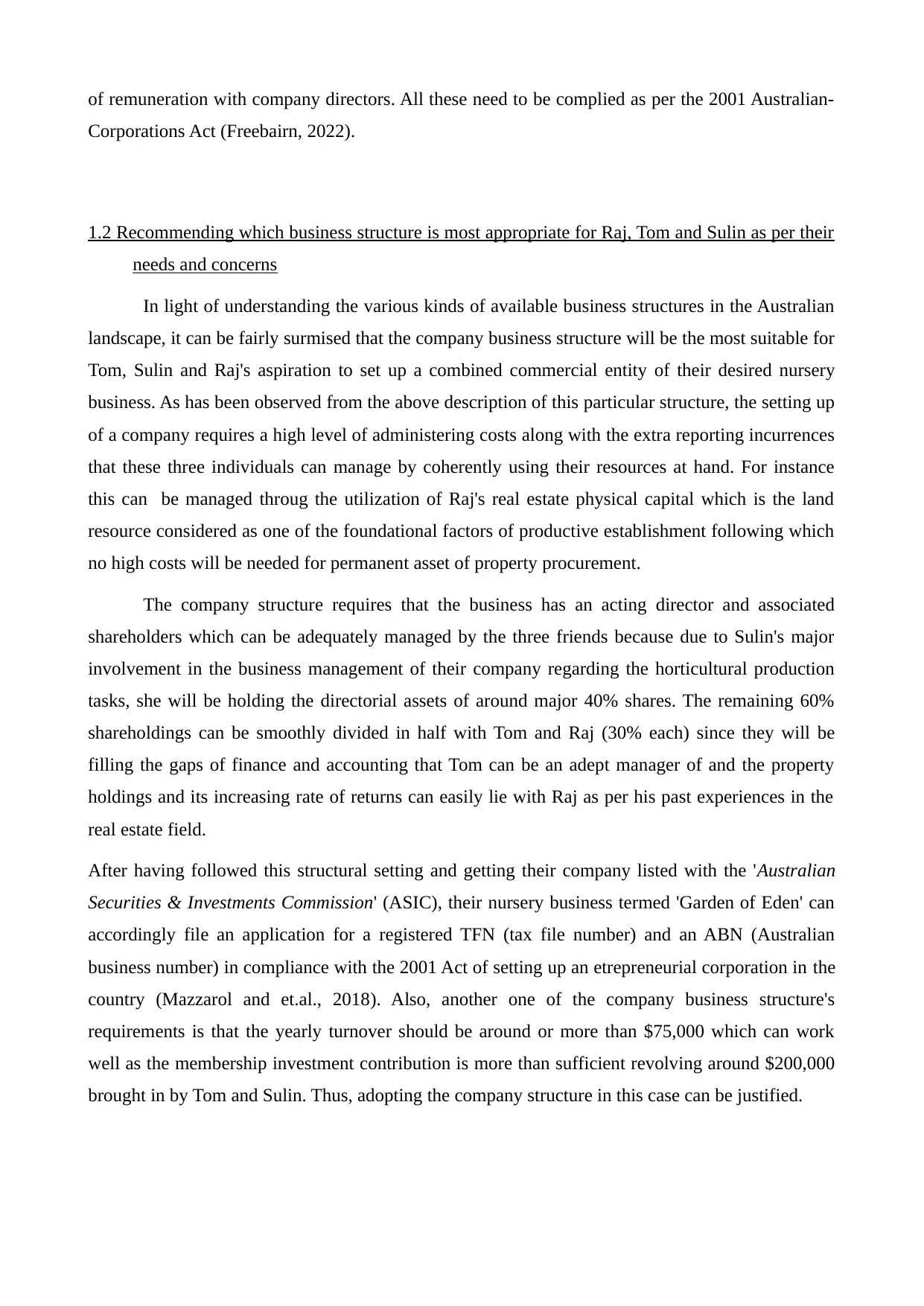
of remuneration with company directors. All these need to be complied as per the 2001 Australian-
Corporations Act (Freebairn, 2022).
1.2 Recommending which business structure is most appropriate for Raj, Tom and Sulin as per their
needs and concerns
In light of understanding the various kinds of available business structures in the Australian
landscape, it can be fairly surmised that the company business structure will be the most suitable for
Tom, Sulin and Raj's aspiration to set up a combined commercial entity of their desired nursery
business. As has been observed from the above description of this particular structure, the setting up
of a company requires a high level of administering costs along with the extra reporting incurrences
that these three individuals can manage by coherently using their resources at hand. For instance
this can be managed throug the utilization of Raj's real estate physical capital which is the land
resource considered as one of the foundational factors of productive establishment following which
no high costs will be needed for permanent asset of property procurement.
The company structure requires that the business has an acting director and associated
shareholders which can be adequately managed by the three friends because due to Sulin's major
involvement in the business management of their company regarding the horticultural production
tasks, she will be holding the directorial assets of around major 40% shares. The remaining 60%
shareholdings can be smoothly divided in half with Tom and Raj (30% each) since they will be
filling the gaps of finance and accounting that Tom can be an adept manager of and the property
holdings and its increasing rate of returns can easily lie with Raj as per his past experiences in the
real estate field.
After having followed this structural setting and getting their company listed with the 'Australian
Securities & Investments Commission' (ASIC), their nursery business termed 'Garden of Eden' can
accordingly file an application for a registered TFN (tax file number) and an ABN (Australian
business number) in compliance with the 2001 Act of setting up an etrepreneurial corporation in the
country (Mazzarol and et.al., 2018). Also, another one of the company business structure's
requirements is that the yearly turnover should be around or more than $75,000 which can work
well as the membership investment contribution is more than sufficient revolving around $200,000
brought in by Tom and Sulin. Thus, adopting the company structure in this case can be justified.
Corporations Act (Freebairn, 2022).
1.2 Recommending which business structure is most appropriate for Raj, Tom and Sulin as per their
needs and concerns
In light of understanding the various kinds of available business structures in the Australian
landscape, it can be fairly surmised that the company business structure will be the most suitable for
Tom, Sulin and Raj's aspiration to set up a combined commercial entity of their desired nursery
business. As has been observed from the above description of this particular structure, the setting up
of a company requires a high level of administering costs along with the extra reporting incurrences
that these three individuals can manage by coherently using their resources at hand. For instance
this can be managed throug the utilization of Raj's real estate physical capital which is the land
resource considered as one of the foundational factors of productive establishment following which
no high costs will be needed for permanent asset of property procurement.
The company structure requires that the business has an acting director and associated
shareholders which can be adequately managed by the three friends because due to Sulin's major
involvement in the business management of their company regarding the horticultural production
tasks, she will be holding the directorial assets of around major 40% shares. The remaining 60%
shareholdings can be smoothly divided in half with Tom and Raj (30% each) since they will be
filling the gaps of finance and accounting that Tom can be an adept manager of and the property
holdings and its increasing rate of returns can easily lie with Raj as per his past experiences in the
real estate field.
After having followed this structural setting and getting their company listed with the 'Australian
Securities & Investments Commission' (ASIC), their nursery business termed 'Garden of Eden' can
accordingly file an application for a registered TFN (tax file number) and an ABN (Australian
business number) in compliance with the 2001 Act of setting up an etrepreneurial corporation in the
country (Mazzarol and et.al., 2018). Also, another one of the company business structure's
requirements is that the yearly turnover should be around or more than $75,000 which can work
well as the membership investment contribution is more than sufficient revolving around $200,000
brought in by Tom and Sulin. Thus, adopting the company structure in this case can be justified.
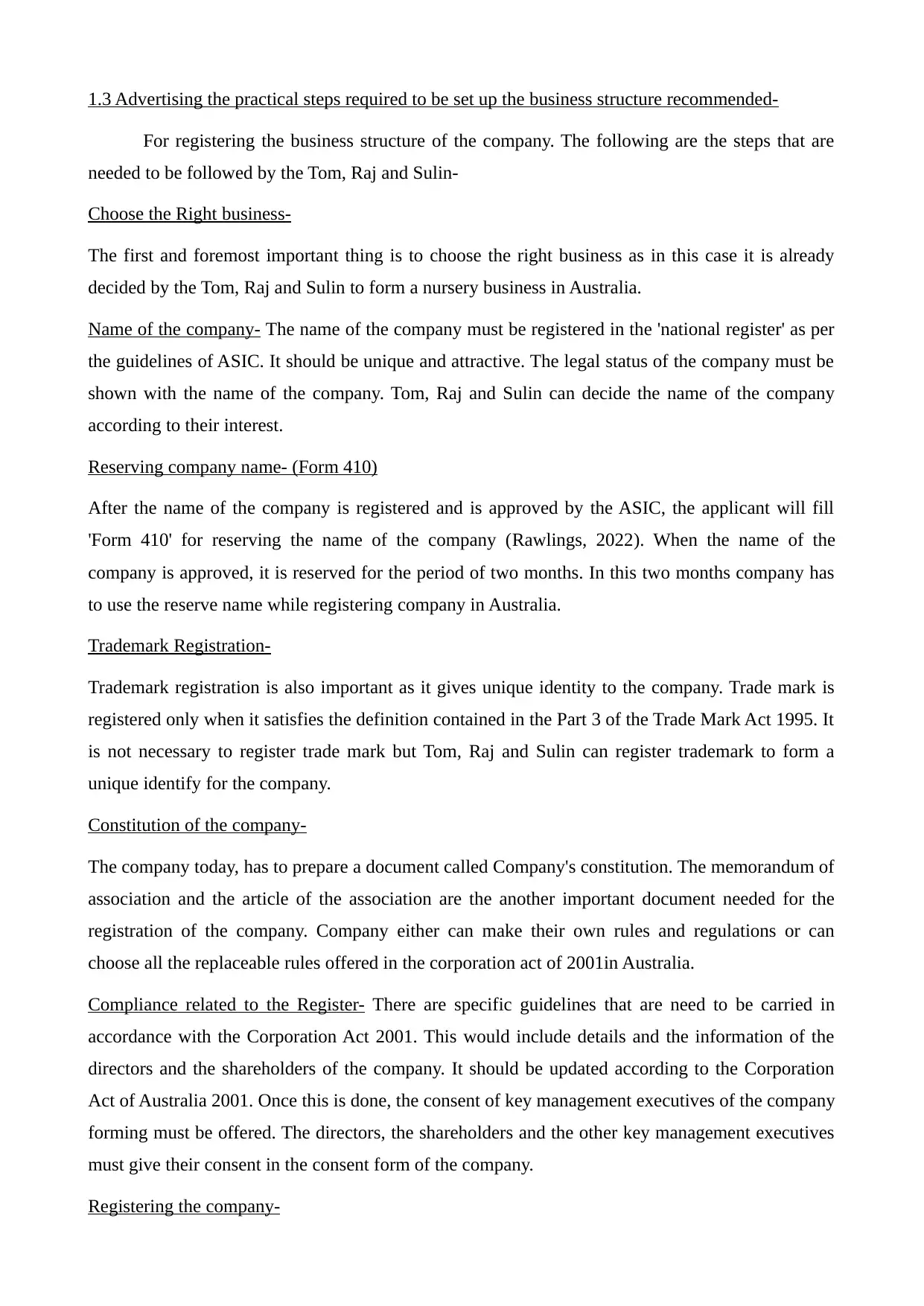
1.3 Advertising the practical steps required to be set up the business structure recommended-
For registering the business structure of the company. The following are the steps that are
needed to be followed by the Tom, Raj and Sulin-
Choose the Right business-
The first and foremost important thing is to choose the right business as in this case it is already
decided by the Tom, Raj and Sulin to form a nursery business in Australia.
Name of the company- The name of the company must be registered in the 'national register' as per
the guidelines of ASIC. It should be unique and attractive. The legal status of the company must be
shown with the name of the company. Tom, Raj and Sulin can decide the name of the company
according to their interest.
Reserving company name- (Form 410)
After the name of the company is registered and is approved by the ASIC, the applicant will fill
'Form 410' for reserving the name of the company (Rawlings, 2022). When the name of the
company is approved, it is reserved for the period of two months. In this two months company has
to use the reserve name while registering company in Australia.
Trademark Registration-
Trademark registration is also important as it gives unique identity to the company. Trade mark is
registered only when it satisfies the definition contained in the Part 3 of the Trade Mark Act 1995. It
is not necessary to register trade mark but Tom, Raj and Sulin can register trademark to form a
unique identify for the company.
Constitution of the company-
The company today, has to prepare a document called Company's constitution. The memorandum of
association and the article of the association are the another important document needed for the
registration of the company. Company either can make their own rules and regulations or can
choose all the replaceable rules offered in the corporation act of 2001in Australia.
Compliance related to the Register- There are specific guidelines that are need to be carried in
accordance with the Corporation Act 2001. This would include details and the information of the
directors and the shareholders of the company. It should be updated according to the Corporation
Act of Australia 2001. Once this is done, the consent of key management executives of the company
forming must be offered. The directors, the shareholders and the other key management executives
must give their consent in the consent form of the company.
Registering the company-
For registering the business structure of the company. The following are the steps that are
needed to be followed by the Tom, Raj and Sulin-
Choose the Right business-
The first and foremost important thing is to choose the right business as in this case it is already
decided by the Tom, Raj and Sulin to form a nursery business in Australia.
Name of the company- The name of the company must be registered in the 'national register' as per
the guidelines of ASIC. It should be unique and attractive. The legal status of the company must be
shown with the name of the company. Tom, Raj and Sulin can decide the name of the company
according to their interest.
Reserving company name- (Form 410)
After the name of the company is registered and is approved by the ASIC, the applicant will fill
'Form 410' for reserving the name of the company (Rawlings, 2022). When the name of the
company is approved, it is reserved for the period of two months. In this two months company has
to use the reserve name while registering company in Australia.
Trademark Registration-
Trademark registration is also important as it gives unique identity to the company. Trade mark is
registered only when it satisfies the definition contained in the Part 3 of the Trade Mark Act 1995. It
is not necessary to register trade mark but Tom, Raj and Sulin can register trademark to form a
unique identify for the company.
Constitution of the company-
The company today, has to prepare a document called Company's constitution. The memorandum of
association and the article of the association are the another important document needed for the
registration of the company. Company either can make their own rules and regulations or can
choose all the replaceable rules offered in the corporation act of 2001in Australia.
Compliance related to the Register- There are specific guidelines that are need to be carried in
accordance with the Corporation Act 2001. This would include details and the information of the
directors and the shareholders of the company. It should be updated according to the Corporation
Act of Australia 2001. Once this is done, the consent of key management executives of the company
forming must be offered. The directors, the shareholders and the other key management executives
must give their consent in the consent form of the company.
Registering the company-
⊘ This is a preview!⊘
Do you want full access?
Subscribe today to unlock all pages.

Trusted by 1+ million students worldwide
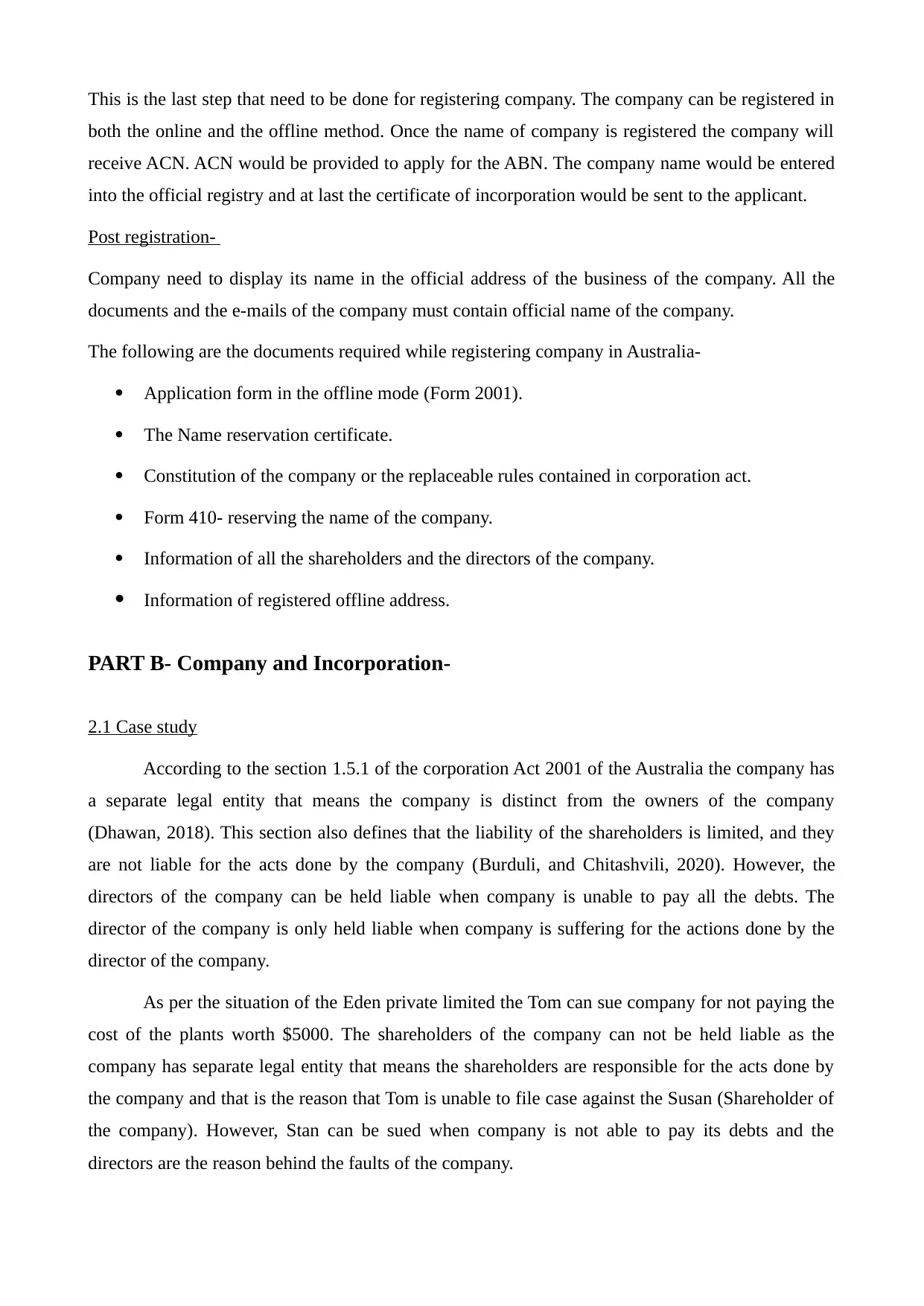
This is the last step that need to be done for registering company. The company can be registered in
both the online and the offline method. Once the name of company is registered the company will
receive ACN. ACN would be provided to apply for the ABN. The company name would be entered
into the official registry and at last the certificate of incorporation would be sent to the applicant.
Post registration-
Company need to display its name in the official address of the business of the company. All the
documents and the e-mails of the company must contain official name of the company.
The following are the documents required while registering company in Australia-
Application form in the offline mode (Form 2001).
The Name reservation certificate.
Constitution of the company or the replaceable rules contained in corporation act.
Form 410- reserving the name of the company.
Information of all the shareholders and the directors of the company.
Information of registered offline address.
PART B- Company and Incorporation-
2.1 Case study
According to the section 1.5.1 of the corporation Act 2001 of the Australia the company has
a separate legal entity that means the company is distinct from the owners of the company
(Dhawan, 2018). This section also defines that the liability of the shareholders is limited, and they
are not liable for the acts done by the company (Burduli, and Chitashvili, 2020). However, the
directors of the company can be held liable when company is unable to pay all the debts. The
director of the company is only held liable when company is suffering for the actions done by the
director of the company.
As per the situation of the Eden private limited the Tom can sue company for not paying the
cost of the plants worth $5000. The shareholders of the company can not be held liable as the
company has separate legal entity that means the shareholders are responsible for the acts done by
the company and that is the reason that Tom is unable to file case against the Susan (Shareholder of
the company). However, Stan can be sued when company is not able to pay its debts and the
directors are the reason behind the faults of the company.
both the online and the offline method. Once the name of company is registered the company will
receive ACN. ACN would be provided to apply for the ABN. The company name would be entered
into the official registry and at last the certificate of incorporation would be sent to the applicant.
Post registration-
Company need to display its name in the official address of the business of the company. All the
documents and the e-mails of the company must contain official name of the company.
The following are the documents required while registering company in Australia-
Application form in the offline mode (Form 2001).
The Name reservation certificate.
Constitution of the company or the replaceable rules contained in corporation act.
Form 410- reserving the name of the company.
Information of all the shareholders and the directors of the company.
Information of registered offline address.
PART B- Company and Incorporation-
2.1 Case study
According to the section 1.5.1 of the corporation Act 2001 of the Australia the company has
a separate legal entity that means the company is distinct from the owners of the company
(Dhawan, 2018). This section also defines that the liability of the shareholders is limited, and they
are not liable for the acts done by the company (Burduli, and Chitashvili, 2020). However, the
directors of the company can be held liable when company is unable to pay all the debts. The
director of the company is only held liable when company is suffering for the actions done by the
director of the company.
As per the situation of the Eden private limited the Tom can sue company for not paying the
cost of the plants worth $5000. The shareholders of the company can not be held liable as the
company has separate legal entity that means the shareholders are responsible for the acts done by
the company and that is the reason that Tom is unable to file case against the Susan (Shareholder of
the company). However, Stan can be sued when company is not able to pay its debts and the
directors are the reason behind the faults of the company.
Paraphrase This Document
Need a fresh take? Get an instant paraphrase of this document with our AI Paraphraser
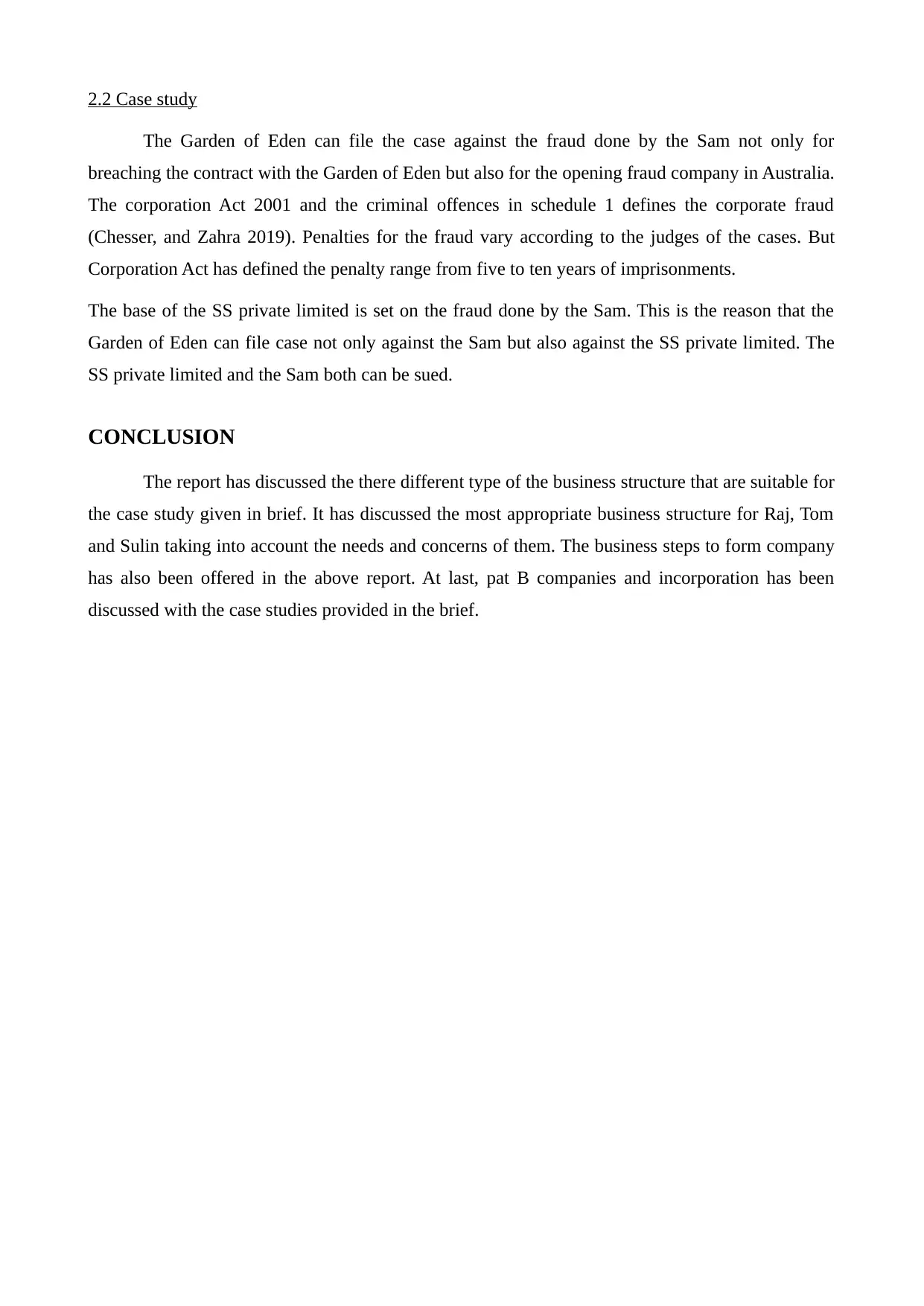
2.2 Case study
The Garden of Eden can file the case against the fraud done by the Sam not only for
breaching the contract with the Garden of Eden but also for the opening fraud company in Australia.
The corporation Act 2001 and the criminal offences in schedule 1 defines the corporate fraud
(Chesser, and Zahra 2019). Penalties for the fraud vary according to the judges of the cases. But
Corporation Act has defined the penalty range from five to ten years of imprisonments.
The base of the SS private limited is set on the fraud done by the Sam. This is the reason that the
Garden of Eden can file case not only against the Sam but also against the SS private limited. The
SS private limited and the Sam both can be sued.
CONCLUSION
The report has discussed the there different type of the business structure that are suitable for
the case study given in brief. It has discussed the most appropriate business structure for Raj, Tom
and Sulin taking into account the needs and concerns of them. The business steps to form company
has also been offered in the above report. At last, pat B companies and incorporation has been
discussed with the case studies provided in the brief.
The Garden of Eden can file the case against the fraud done by the Sam not only for
breaching the contract with the Garden of Eden but also for the opening fraud company in Australia.
The corporation Act 2001 and the criminal offences in schedule 1 defines the corporate fraud
(Chesser, and Zahra 2019). Penalties for the fraud vary according to the judges of the cases. But
Corporation Act has defined the penalty range from five to ten years of imprisonments.
The base of the SS private limited is set on the fraud done by the Sam. This is the reason that the
Garden of Eden can file case not only against the Sam but also against the SS private limited. The
SS private limited and the Sam both can be sued.
CONCLUSION
The report has discussed the there different type of the business structure that are suitable for
the case study given in brief. It has discussed the most appropriate business structure for Raj, Tom
and Sulin taking into account the needs and concerns of them. The business steps to form company
has also been offered in the above report. At last, pat B companies and incorporation has been
discussed with the case studies provided in the brief.
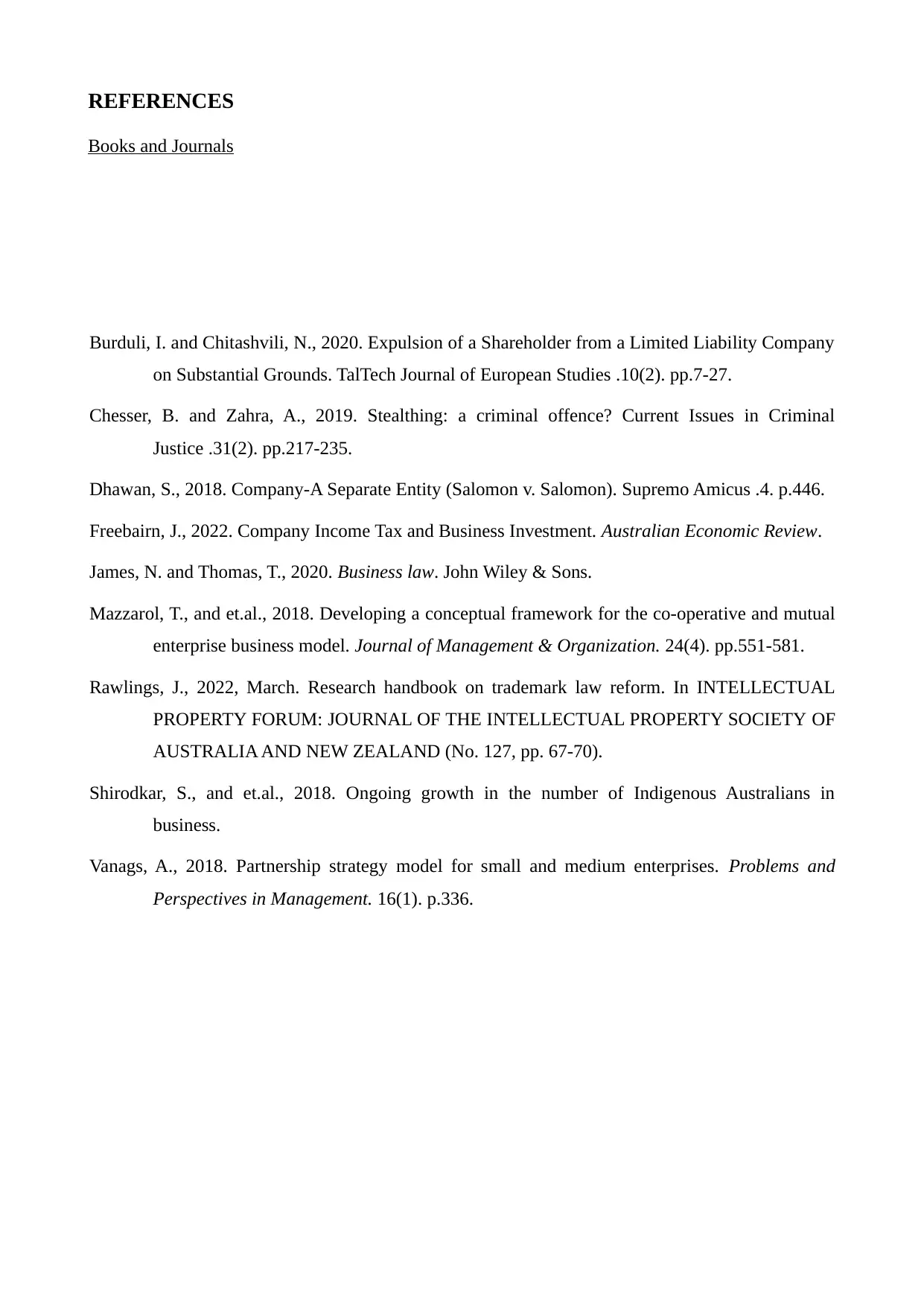
REFERENCES
Books and Journals
Burduli, I. and Chitashvili, N., 2020. Expulsion of a Shareholder from a Limited Liability Company
on Substantial Grounds. TalTech Journal of European Studies .10(2). pp.7-27.
Chesser, B. and Zahra, A., 2019. Stealthing: a criminal offence? Current Issues in Criminal
Justice .31(2). pp.217-235.
Dhawan, S., 2018. Company-A Separate Entity (Salomon v. Salomon). Supremo Amicus .4. p.446.
Freebairn, J., 2022. Company Income Tax and Business Investment. Australian Economic Review.
James, N. and Thomas, T., 2020. Business law. John Wiley & Sons.
Mazzarol, T., and et.al., 2018. Developing a conceptual framework for the co-operative and mutual
enterprise business model. Journal of Management & Organization. 24(4). pp.551-581.
Rawlings, J., 2022, March. Research handbook on trademark law reform. In INTELLECTUAL
PROPERTY FORUM: JOURNAL OF THE INTELLECTUAL PROPERTY SOCIETY OF
AUSTRALIA AND NEW ZEALAND (No. 127, pp. 67-70).
Shirodkar, S., and et.al., 2018. Ongoing growth in the number of Indigenous Australians in
business.
Vanags, A., 2018. Partnership strategy model for small and medium enterprises. Problems and
Perspectives in Management. 16(1). p.336.
Books and Journals
Burduli, I. and Chitashvili, N., 2020. Expulsion of a Shareholder from a Limited Liability Company
on Substantial Grounds. TalTech Journal of European Studies .10(2). pp.7-27.
Chesser, B. and Zahra, A., 2019. Stealthing: a criminal offence? Current Issues in Criminal
Justice .31(2). pp.217-235.
Dhawan, S., 2018. Company-A Separate Entity (Salomon v. Salomon). Supremo Amicus .4. p.446.
Freebairn, J., 2022. Company Income Tax and Business Investment. Australian Economic Review.
James, N. and Thomas, T., 2020. Business law. John Wiley & Sons.
Mazzarol, T., and et.al., 2018. Developing a conceptual framework for the co-operative and mutual
enterprise business model. Journal of Management & Organization. 24(4). pp.551-581.
Rawlings, J., 2022, March. Research handbook on trademark law reform. In INTELLECTUAL
PROPERTY FORUM: JOURNAL OF THE INTELLECTUAL PROPERTY SOCIETY OF
AUSTRALIA AND NEW ZEALAND (No. 127, pp. 67-70).
Shirodkar, S., and et.al., 2018. Ongoing growth in the number of Indigenous Australians in
business.
Vanags, A., 2018. Partnership strategy model for small and medium enterprises. Problems and
Perspectives in Management. 16(1). p.336.
⊘ This is a preview!⊘
Do you want full access?
Subscribe today to unlock all pages.

Trusted by 1+ million students worldwide
1 out of 9
Related Documents
Your All-in-One AI-Powered Toolkit for Academic Success.
+13062052269
info@desklib.com
Available 24*7 on WhatsApp / Email
![[object Object]](/_next/static/media/star-bottom.7253800d.svg)
Unlock your academic potential
Copyright © 2020–2025 A2Z Services. All Rights Reserved. Developed and managed by ZUCOL.





